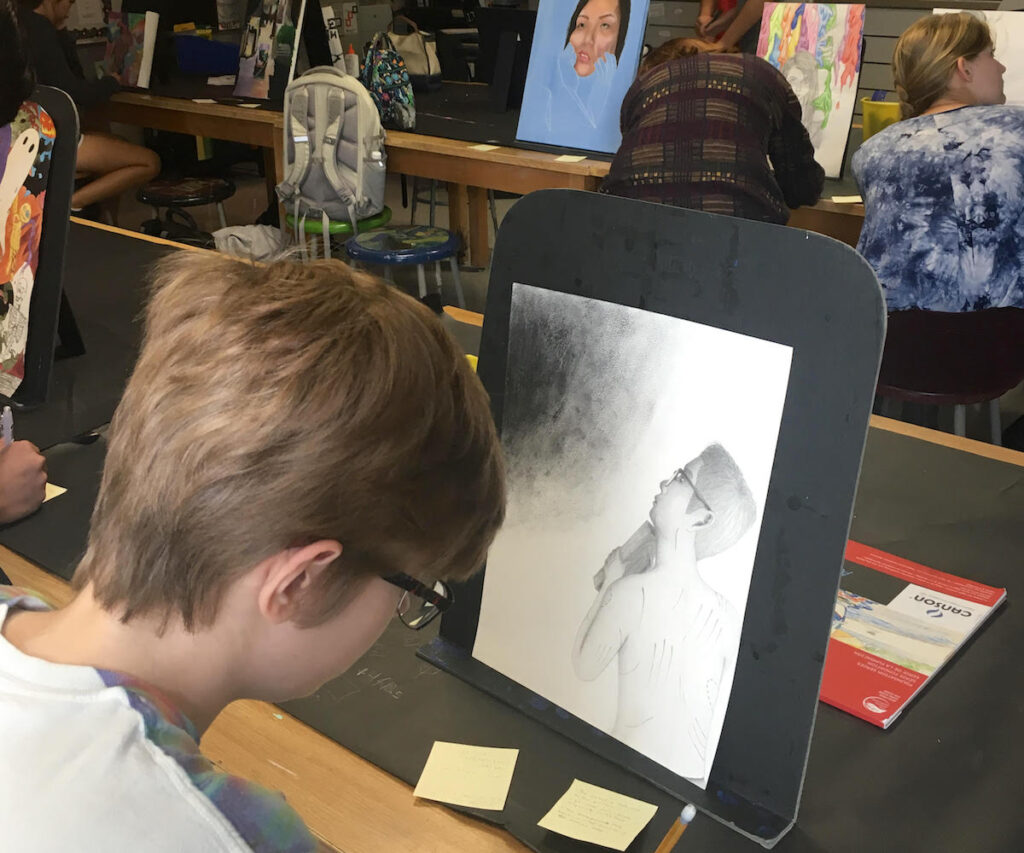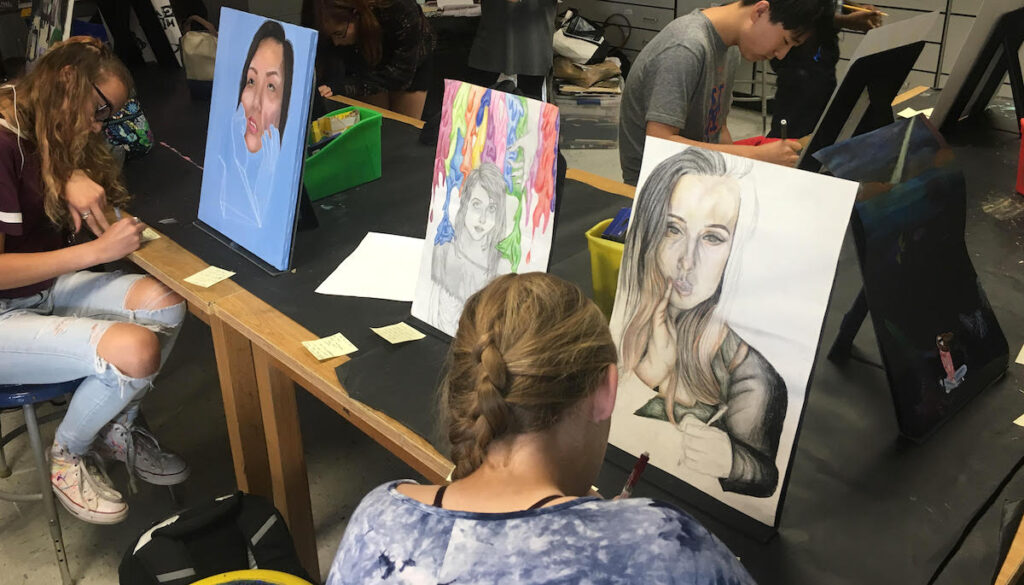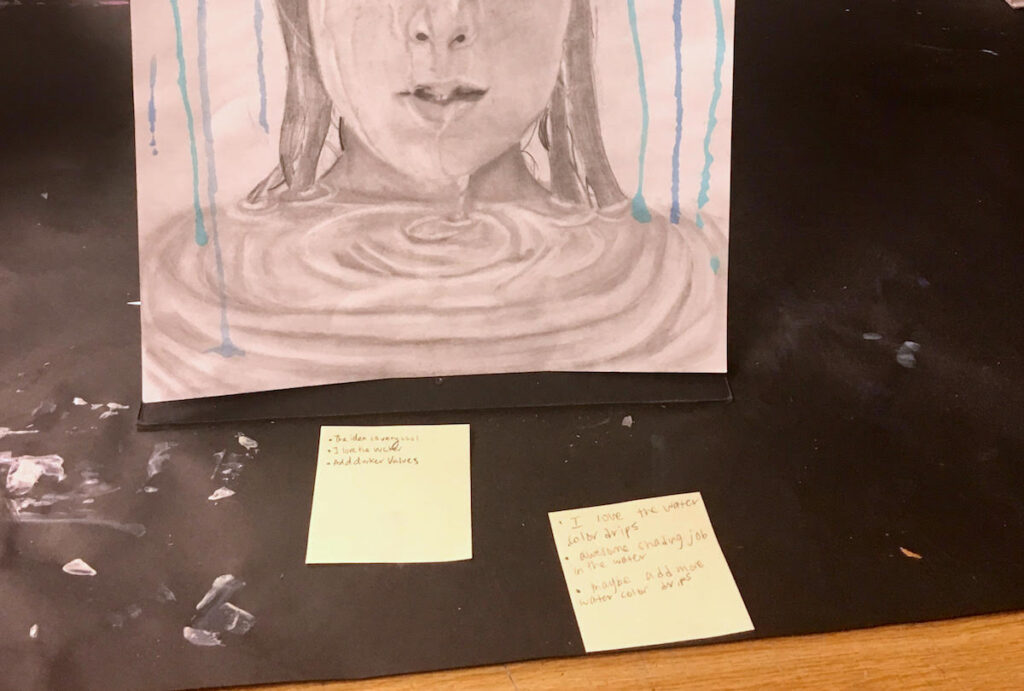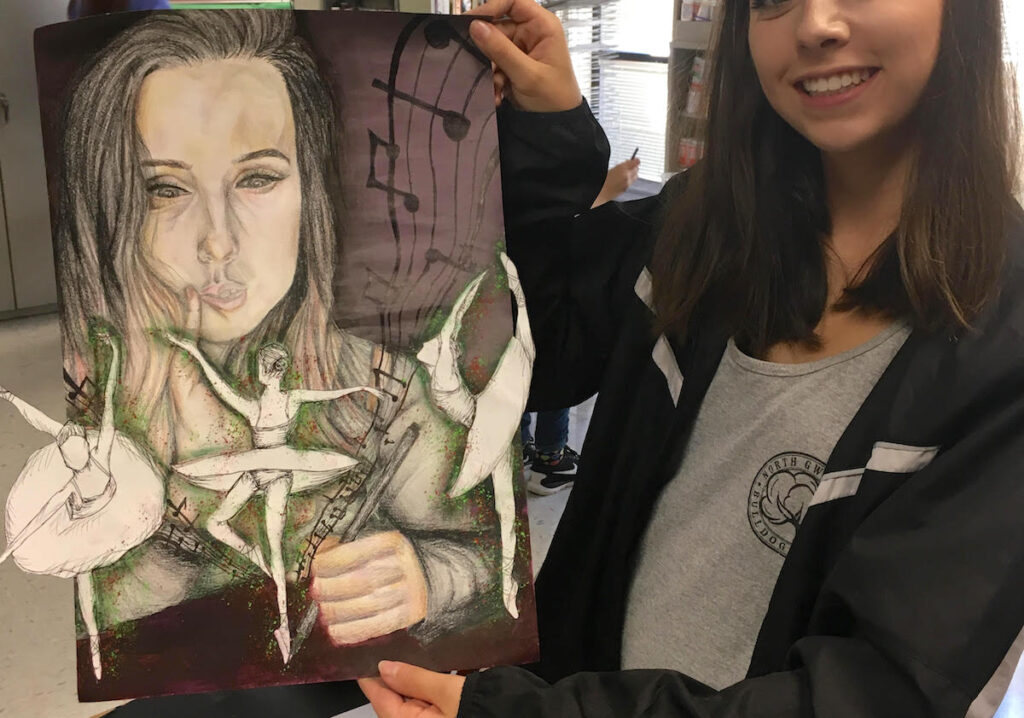Back in my early days of teaching, I was always a bit hesitant to take away studio time for critiques, but my students were missing out on an important part of their art education.
I knew I didn’t have time for long, drawn-out methods, but I also knew critiques were necessary.
So, I did some research and asked others in the field why they thought class critiques were necessary and how they went about fitting in this often daunting task.
Here are 4 reasons all art teachers should make room for critiques in their curriculum.

1. Students value what their peers think.
Believe it or not, students like to talk about their art and the art of their peers. Dr. Lauren Phillips, a teaching colleague of mine with over 19 years experience, echoed this thought. She told me, “I find that my students sometimes put more weight on what their peers say. Especially when their peers say the exact thing I’ve been saying! Class critiques are valuable because those other points of view can see more than our individual eyes can.”
2. Critiques allow students to dive deep.
Dr. Marvin Bartel, Emeritus Professor of Art at Goshen College, echoes this thought in his essay, Empathetic Critique. He writes, “Empathic critique is collaboration, not competition. Empathic class critique in studio art is not a debate session. It is a hunt for visual effects, meaning, purpose, and new ideas. Competition is replaced by mutual discovery.” Making your students feel comfortable with the critique process and developing a positive classroom climate will go a long way to helping students open up. Then they can really dive deep with their peers to find ways to push their art to the next level.
Are you looking for even more tips about running critiques in the art room? If so, you won’t want to miss the Art Ed PRO Learning Pack, Finding Success with Critique at Every Level. You’ll explore methods for simplifying critique methods and activities, discover how to encourage students to reflect on their artmaking for increased engagement, and so much more!
3. Without critiques, your students’ view of their artwork is limited.
Stan Dodson, a teacher at Burke County High School, echoes many of these same thoughts when he describes why critique is so important. He told me, “Critiquing work is such an invaluable method for growth and process. Without this measure of understanding, our lens is limited, and thus our growth stalled. I infuse critiquing through informal and formal applications.
Students seem to receive the words from their peers more in kind than from their instructor. I’m not sure if that’s fear of failure or if they empathize more with a peer, but the words the students use often align with much of what I would say. This perhaps is the greatest compliment to a successful teaching environment in that your students are now modeling your methodology. An effective critiquing style must be taught and modeled. A safe environment must be cultivated, and from this base, authentic words and feedback will stem.”
4. Critiques foster collaboration and community.
Dr. Drew Brown, past president of the GAEA, agrees. She said, “I think critique is important because as artists we work alone with media in the process of creating.” She then went on to describe the power critiques have to help people build relationships saying, “Critiques gives us a chance to interact with the art as the focal point. In doing so, we get to know each other better. We establish trust; we are able to discuss our perceptions, interpretations, and values in a safe space. In synthesizing and verbalizing our ideas, we understand ourselves better. At the same time, we begin to understand others, their motivations, and beliefs. This can hold true with class critiques or by critiquing master works of art.”
My Favorite Way to Run a Critique in the Art Room
There are many different ways to run critiques in the classroom. Tim Bogatz wrote a great article for the Art of Education a few years ago detailing seven different ways to conduct informative and fun critiques. If you’d like to explore even more, here’s everything we’ve ever published on the subject.
In my room, I tend to keep a similar format for all of my classes, from Intro to Art all the way through AP. Because they get so familiar with the process, my students look forward to our critique days now! I always conduct in-process critiques, so students can take what they’ve learned and immediately apply it as they continue to work on their final pieces.
It’s fun to surprise students with critique days now and then. However, you know your students best, so if they don’t like surprises, you may want to give them a heads up.
Here are 6 simple steps to the “Glow and Grow” Critique – my favorite!
1. Set up the artwork.
As I said, I like to surprise my kids with their critique days. As they walk into class, I have our table easels out, and they know it’s time to do some thinking and some talking! Students grab a table easel and get their art off their shelf and set it up. You can have your students set up their work in whatever way works best for you!
2. Pass out sticky notes.
The next step is to pass out sticky notes. This is where the students will be writing their feedback. In my room, I require each student to start with three. If time allows, they can certainly do more.
3. Observe the art.
Once everyone has their sticky notes ready to go, give your students about five minutes to quietly walk around the room and just look at the art. There’s no writing or talking during this time. Instead, the students should be quietly reflecting and thinking about the work created by their classmates.

4: Choose 3 piece of art and give feedback.
At the end of five minutes, students are asked to choose an artwork and write down two “Glows” (what is working really well) and one “Grow” (what could be improved and why or how) on their sticky note. Students are deep in thought during this stage and writing meaningful notes to their peers. These sticky notes are left next to the art, and each student moves on and does two more.

For a slightly different take on how to run a “Glow-and Grow” Critique, check out this article from our archives.
5: Read the comments.
Students are asked to go back to their art and read the comments left for them. This is an important time to reflect on what their peers have to say about their current works.
6: Hold a group discussion.
Finally, in my room, we open up the critique for a quick discussion and talk about the pieces in the room that are working well and discuss why. Students are excited to talk about the art, and it’s always great to see how they are guiding one another in a constructive and kind atmosphere.
Part of the reason I like this process is that the whole thing takes only about 20 minutes. Therefore, students have time to use the information they’ve been given and spend the last part of the class in studio mode.

I think another exciting part of this established class routine is reading my students’ final self-assessments. I love to hear how they completed their pieces by using the information they received from their peers. It’s always exciting to see our kids create, but when they reflect and learn, and their art goes to the next level, that’s when we know we’ve done our jobs well!
Do you think class critiques are an important part of your practice?
How do you have your students reflect on their own art and the art of their peers?
Magazine articles and podcasts are opinions of professional education contributors and do not necessarily represent the position of the Art of Education University (AOEU) or its academic offerings. Contributors use terms in the way they are most often talked about in the scope of their educational experiences.





